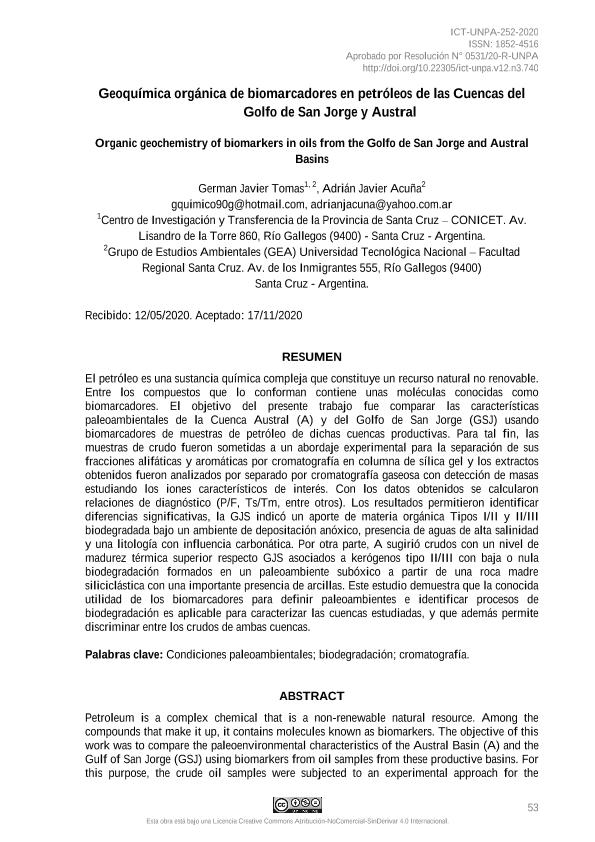Mostrar el registro sencillo del ítem
dc.contributor.author
Tomas, Germán Javier

dc.contributor.author
Acuña, Adrian Javier

dc.date.available
2022-10-05T18:36:36Z
dc.date.issued
2020-12-14
dc.identifier.citation
Tomas, Germán Javier; Acuña, Adrian Javier; Geoquímica orgánica de biomarcadores en petróleos de las Cuencas del Golfo de San Jorge y Austral; Universidad Nacional de la Patagonia Austral. Secretaría de Ciencia y Tecnología; Informes Científicos y Técnicos; 12; 3; 14-12-2020; 53-65
dc.identifier.issn
1852-4516
dc.identifier.uri
http://hdl.handle.net/11336/172033
dc.description.abstract
El petróleo es una sustancia química compleja que constituye un recurso natural no renovable. Entre los compuestos que lo conforman contiene unas moléculas conocidas como biomarcadores. El objetivo del presente trabajo fue comparar las características paleoambientales de la Cuenca Austral (A) y del Golfo de San Jorge (GSJ) usando biomarcadores de muestras de petróleo de dichas cuencas productivas. Para tal fin, las muestras de crudo fueron sometidas a un abordaje experimental para la separación de sus fracciones alifáticas y aromáticas por cromatografía en columna de sílica gel y los extractos obtenidos fueron analizados por separado por cromatografía gaseosa con detección de masas estudiando los iones característicos de interés. Con los datos obtenidos se calcularon relaciones de diagnóstico (P/F, Ts/Tm, entre otros). Los resultados permitieron identificar diferencias significativas, la GJS indicó un aporte de materia orgánica Tipos I/II y II/III biodegradada bajo un ambiente de depositación anóxico, presencia de aguas de alta salinidad y una litología con influencia carbonática. Por otra parte, A sugirió crudos con un nivel de madurez térmica superior respecto GJS asociados a kerógenos tipo II/III con baja o nula biodegradación formados en un paleoambiente subóxico a partir de una roca madre siliciclástica con una importante presencia de arcillas. Este estudio demuestra que la conocida utilidad de los biomarcadores para definir paleoambientes e identificar procesos de biodegradación es aplicable para caracterizar las cuencas estudiadas, y que además permite discriminar entre los crudos de ambas cuencas.
dc.description.abstract
Petroleum is a complex chemical that is a non-renewable natural resource. Among the compounds that make it up, it contains molecules known as biomarkers. The objective of this work was to compare the paleoenvironmental characteristics of the Austral Basin (A) and the Gulf of San Jorge (GSJ) using biomarkers from oil samples from these productive basins. For this purpose, the crude oil samples were subjected to an experimental approach for the separation of their aliphatic and aromatic fractions by silica gel column chromatography and the extracts obtained were analyzed separately by gas chromatography with mass detection studying the characteristic ions of interest. With the data obtained, diagnostic relationships (P/F, Ts/Tm, among others) were calculated. The results allowed identifying significant differences in the results of the biomarkers according to the basin from which the studied oil comes. The results obtained for the GJS indicate a contribution of organic matter Types I/II and II/III biodegraded under an anoxic deposition environment, presence of high salinity waters and a lithology with carbonate influence. On the other hand, the results of A suggest crude oils with a higher level of thermal maturity associated with type II/III kerogens with low or no biodegradation formed in a sub-toxic paleoenvironment from a siliciclastic bedrock with a significant presence of clays. This study shows that the well-known usefulness of biomarkers to define paleoenvironments and identify biodegradation processes is applicable to characterize the studied basins, and that it allows discriminating between crude oils from both basins.
dc.format
application/pdf
dc.language.iso
spa
dc.publisher
Universidad Nacional de la Patagonia Austral. Secretaría de Ciencia y Tecnología
dc.rights
info:eu-repo/semantics/openAccess
dc.rights.uri
https://creativecommons.org/licenses/by-nc-nd/2.5/ar/
dc.subject
CONDICIONES PALEOAMBIENTALES
dc.subject
BIODEGRADACIÓN
dc.subject
CROMATOGRAFÍA
dc.subject.classification
Geoquímica y Geofísica

dc.subject.classification
Ciencias de la Tierra y relacionadas con el Medio Ambiente

dc.subject.classification
CIENCIAS NATURALES Y EXACTAS

dc.title
Geoquímica orgánica de biomarcadores en petróleos de las Cuencas del Golfo de San Jorge y Austral
dc.title
Organic geochemistry of biomarkers in oils from the Golfo de San Jorge and Austral Basins
dc.type
info:eu-repo/semantics/article
dc.type
info:ar-repo/semantics/artículo
dc.type
info:eu-repo/semantics/publishedVersion
dc.date.updated
2022-10-03T18:05:40Z
dc.identifier.eissn
1852-4516
dc.journal.volume
12
dc.journal.number
3
dc.journal.pagination
53-65
dc.journal.pais
Argentina

dc.journal.ciudad
Río Gallegos
dc.description.fil
Fil: Tomas, Germán Javier. Consejo Nacional de Investigaciones Científicas y Técnicas. Centro de Investigaciones y Transferencia de Santa Cruz. Universidad Tecnológica Nacional. Facultad Regional Santa Cruz. Centro de Investigaciones y Transferencia de Santa Cruz. Universidad Nacional de la Patagonia Austral. Centro de Investigaciones y Transferencia de Santa Cruz; Argentina
dc.description.fil
Fil: Acuña, Adrian Javier. Universidad Tecnológica Nacional. Facultad Regional Santa Cruz; Argentina
dc.journal.title
Informes Científicos y Técnicos
dc.relation.alternativeid
info:eu-repo/semantics/altIdentifier/url/https://publicaciones.unpa.edu.ar/index.php/ICTUNPA/article/view/740
dc.relation.alternativeid
info:eu-repo/semantics/altIdentifier/doi/http://doi.org/10.22305/ict-unpa.v12.n3.740
Archivos asociados
